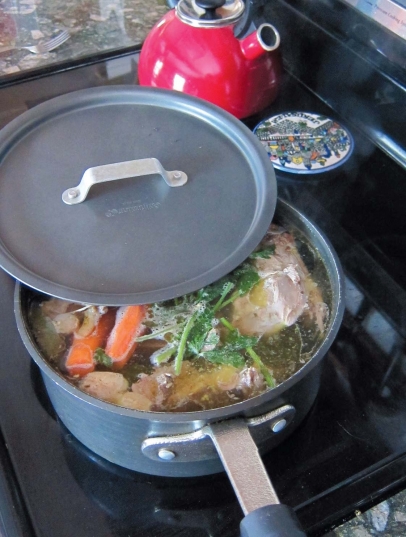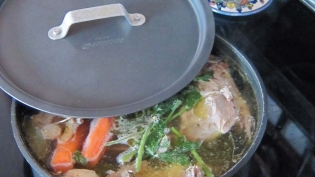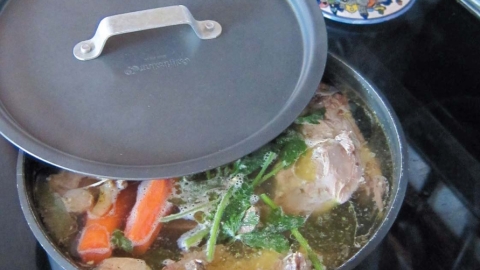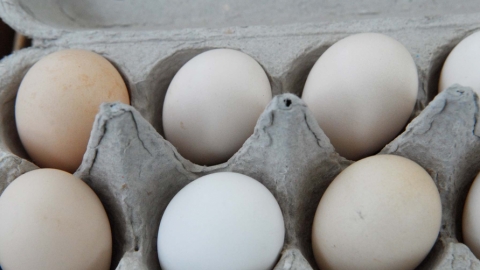Good as Gold: Poultry Stock
I have always wanted to start a culinary campaign, one with the slogan, “Save the Carcass!” The holiday bird carcass, that is. Millions of them end up in garbage cans after the holidays each year, but they could be put to excellent use instead—to make stock.
The time might be ripe for my crusade, given all the attention paid to bone broth these days (see Terri Milligan’s story in this issue). Stock, a kissing cousin to bone broth, is the clear, flavorful liquid that results when you extract the essence of poultry bones by slow-simmering them in water for several hours. (It works with beef and other meats, fish and vegetables, too). Culinary stock, like monetary stock, is a valuable investment— it tastes terrific, is economical and wholesome, and lends richness to a wide range of foods. In other words, it gives back much more than you put into it.
Bone broth—which simmers for much longer than stock—is popular these days for its health-giving properties. Stock, on the other hand, has been a boon to good cooks for millennia. Especially chicken stock, which is called for in so many recipes. When people say a soup seems homemade or a sauce is incredibly delicious, nine times out of 10, it’s chicken stock that is doing the trick. (Turkey stock would do it, too, if only we would save those carcasses!)
Poultry stock is easy to make. Really. If you can’t boil water, all the better, for the secret to a clear, deep-flavored broth is very gentle simmering. Contrary to the opinion that only professional chefs and DIY-ers have the time for it, stock-making is suited to today’s multi-tasking schedules. Just combine the ingredients, set the flame low and let it bubble lazily for several hours while you go about your other business. Even straining the liquid once the stock is done won’t strain you; just pour it through a colander that’s been lined with cheesecloth.
There are refinements, of course, and many tips for making poultry stock. Start with naturally raised chicken (or turkey) from local sources like Waseda Farms. You can get a very decent batch of stock from mere bones (necks and backs add gelatinous body) and water (for better extraction, start with cold). But the flavor is enhanced with meat, aromatic vegetables and small amounts of seasonings.
My go-to vegetables for poultry stock are carrots and onions (and sometimes celery or mushrooms). For seasonings, I favor whole peppercorns and parsley or thyme (these can be fresh or dried). Since these ingredients give up their essence more quickly than bones, I like to add them later in the cooking process, but they can go in at the beginning, too. I never use vegetables that smell “skunky” when overcooked, like broccoli and cabbage, but I do occasionally add extras like garlic cloves or cilantro roots, to give a specific international flavor to the broth … or just because I have them on hand.
One thing I don’t add is salt – not until the stock is done and ready for tasting, that is, or until the point when I use it in a recipe. This is just to be on the safe side, because as a pre-salted liquid concentrates, so does its saltiness, and I don’t want to accidently overdo it.
To improve the flavor and color of stock, some cooks sauté or roast the ingredients to brown them before adding them to the pot. When I don’t have the time or inclination for this, I add raw onion skins, which give the broth a darker hue.
Skimming the stock after it comes to a simmer is advisable; this removes coagulated proteins that rise to the surface as it cooks, although the worst that can happen if you’re not careful with this step is some cloudiness in the liquid.
Winter is the perfect time for stock preparation. And Northeastern Wisconsin is the perfect place. Think of it as the cold-weather counterpart to the food preservation tasks of the summer harvest. The broth will warm and perfume your kitchen, and you can even let it cool down on your back porch. For a big batch, collect bones and vegetables in the freezer until you have enough to fill a pot … or haul out that turkey carcass you’ll freeze during the holidays. (You will save that, won’t you?) Ladle cooled-down stock into plastic containers to freeze. They’ll add a little magic to your cooking for weeks to come.
And stock really does have a magical side. I remember a day years ago, during my tenure as head chef at a restaurant in Madison. I had just boned several chickens and was covering the scraps with water in a pot, when an employee, looking dubious, asked me what I was doing. “Making stock,” I told him, explaining how the heating liquid would draw flavor from the bones to create a savory broth. “That’s crazy,” scoffed the novice cook, “You can’t get something from nothing.”
Like a potion distilled from sun blinks and cloud burps, the miracle of poultry stock is a little hard to believe. But the real enchantment is its power to transform soups, sauces, stews, gravies, grain dishes and so many other preparations from good dishes to great ones.
So, please: Save the Carcass!
The Same, But Different
WHAT’S THE DIFFERENCE between broth, stock and bone broth? They are closely related to each other, but not exactly the same. All start with water and all contain meat and/or bones, vegetables and aromatic seasonings. All cook at a slow simmer, to extract flavor and nutrients from the ingredients, and all are strained and used for a variety of culinary purposes.
Broth is the lightest of the three concoctions, both in flavor and texture, because it’s cooked for a relatively short time, usually under two hours. It can be seasoned and enjoyed as a hot beverage or used as a base in soups, stews and the like.
Stock is cooked longer, four to six hours, which is enough time to release collagen from the bones and tissues of the meat, which in turn creates a deeply flavored, gelatinous liquid. (Chilled, it will become thicker and be jiggly.) Stock is a culinary workhorse, the flavor foundation for sauces, soups, stews, pilafs, risottos and so, so much more. You can also drink it.
Bone broth cooks the longest, often up to 24 hours and even longer. The idea here is to release as much of the nutrients as possible in order to create a warming, extra-healthful elixir. And it can also be used in culinary preparations.
These days, the terms broth, stock and bone broth are sometimes used interchangeably. And it’s true—they’re very similar. They’re just not the same.








